Elizabeth Moon's Blog, page 6
June 5, 2016
Why the Gaps?
So it's been, um, a month and a day since a post. What kind of way is that to do social media, someone will ask.
LifeStuff. Pressure of work and health issues. Pressure of work always limits the time I have to compose posts--writing for social media competes directly with writing for a living. (No, I don't want to monetize a blog. I don't have ads on my sites or blogs for a reason.) Sometimes I have spare time after doing a day's regular work, and then--sometimes it's fun to write a post here or on one of my other venues. And sometimes I not only have no spare time, but am working past my physical limits to get the work done.
Personally, I hate that getting older means being forced to admit limitations. I've always been a workhorse, happy with my shoulders into the collar. But even a workhorse gets old. For the past few years---and it may be more than a few--I've been pushing and pushing and pushing to keep up with the level of productivity I used to have. Dropping off one non-official duty after another to keep the main line functioning, until, this spring, I realized I was not just losing ground on those things, but on actual physical health. I'll spare you the details (won't interest most of you, and those who think they have to know--butt out.) And my writing was suffering, too, by the past six months at least.
So early last month, finally admitting the damage done, I decided to make a change (and was almost immediately hit with the need to do a rewrite that pushed me right back into the harmful patterns of too little sleep, grabbing whatever was around to eat) and am, with medical advice, on a new regimen. It's amazing how the brain clears with a week or so of 8 hours a night and regular meals of actual real food. (Because we live 50 miles from the city, obtaining and cooking actual food takes hours that I hadn't spent for awhile.) Recovering health and fitness will take longer, of course, and include recommended vigorous exercise, but clearly this was a necessary change.
What it means for those of you who read my books (and aren't here just to look at pictures of knitting, the land, and/or the occasional political rants (of which there will be a couple today, just warning those who hate them) is that I have to work fewer hours to have hours for sleep, cooking the right foods, and exercise. Fewer hours writing means, of course, slower production. Right now it's VERY slow, because regaining health is the priority. More than a couple of hours at the computer a day and my concentration frays. I hope--and actually expect--it will improve, but I doubt I'll be able to maintain the same amount that I did 10 years ago. Better less writing done well, than more done badly.
Expect some delays. Understand the necessity. I'm not quitting--I'm regrouping.
LifeStuff. Pressure of work and health issues. Pressure of work always limits the time I have to compose posts--writing for social media competes directly with writing for a living. (No, I don't want to monetize a blog. I don't have ads on my sites or blogs for a reason.) Sometimes I have spare time after doing a day's regular work, and then--sometimes it's fun to write a post here or on one of my other venues. And sometimes I not only have no spare time, but am working past my physical limits to get the work done.
Personally, I hate that getting older means being forced to admit limitations. I've always been a workhorse, happy with my shoulders into the collar. But even a workhorse gets old. For the past few years---and it may be more than a few--I've been pushing and pushing and pushing to keep up with the level of productivity I used to have. Dropping off one non-official duty after another to keep the main line functioning, until, this spring, I realized I was not just losing ground on those things, but on actual physical health. I'll spare you the details (won't interest most of you, and those who think they have to know--butt out.) And my writing was suffering, too, by the past six months at least.
So early last month, finally admitting the damage done, I decided to make a change (and was almost immediately hit with the need to do a rewrite that pushed me right back into the harmful patterns of too little sleep, grabbing whatever was around to eat) and am, with medical advice, on a new regimen. It's amazing how the brain clears with a week or so of 8 hours a night and regular meals of actual real food. (Because we live 50 miles from the city, obtaining and cooking actual food takes hours that I hadn't spent for awhile.) Recovering health and fitness will take longer, of course, and include recommended vigorous exercise, but clearly this was a necessary change.
What it means for those of you who read my books (and aren't here just to look at pictures of knitting, the land, and/or the occasional political rants (of which there will be a couple today, just warning those who hate them) is that I have to work fewer hours to have hours for sleep, cooking the right foods, and exercise. Fewer hours writing means, of course, slower production. Right now it's VERY slow, because regaining health is the priority. More than a couple of hours at the computer a day and my concentration frays. I hope--and actually expect--it will improve, but I doubt I'll be able to maintain the same amount that I did 10 years ago. Better less writing done well, than more done badly.
Expect some delays. Understand the necessity. I'm not quitting--I'm regrouping.
Published on June 05, 2016 08:44
May 5, 2016
80 Acres: May 5, 2016
Most but not all the surface water has dried up, soils that were seeping and running with water last week are dry enough to walk on in regular shoes.

Main grass: Queen Anne's Lace, gaillardia, scattered bluebonnets
stiff-stem prairie flax, coreopsis, goldthread, Venus's looking glass,
skullcap, green antelope horns, others
With enough water running on the surface for long enough, we can have an abundance of wet-weather plants, including some in the mint family. One of the showiest is obedient-plant, which we transplanted planted a shovel-full of from a wet area about to undergo "development" somewhere else.
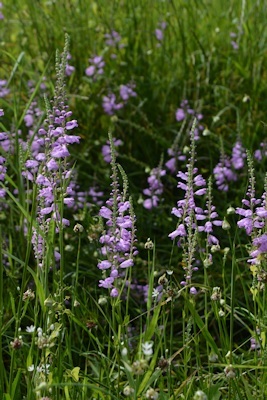
It grows several feet tall, if it's really happy--always at least 18 inches--with these big, glowing, lavender flowers that catch the light. Bees love it. The honeybees wrestle their way inside from the front; bumblebees more often bite a hole near the nectar.
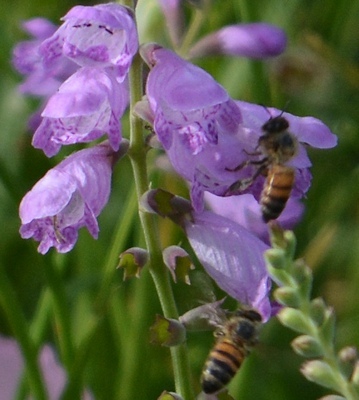
It has slowly spread over the years since we introduced it--faster in wet years, of course. Right here it's growing with wild onion (at the end of its flowering) and is overlapping other flower types the bees enjoy. Bees were too busy toward late afternoon to let me catch them on anything but the obedient plant.
Although I didn't photograph bees on anything but this, I did see quite a few butterflies and caught this one on Queen Anne's Lace. It's a Common Buckeye, with the sun coming through one wing.
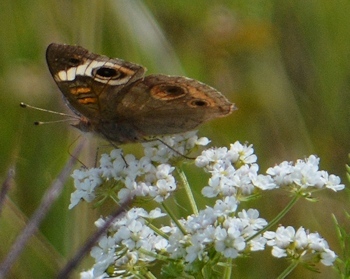
Also with a preference for damp soil--but not growing in water--is Venus's looking glass, a delicate little plant with purple star-shaped flowers along a single stem.
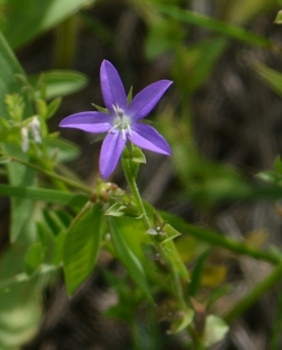
We don't see these in dry years.
On slightly damp ground, a smaller mint-family plant with lavender and white flowers:
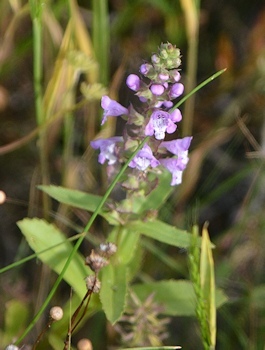
Toward the bottom-center of image is another, even smaller mint-family plant just past flowering
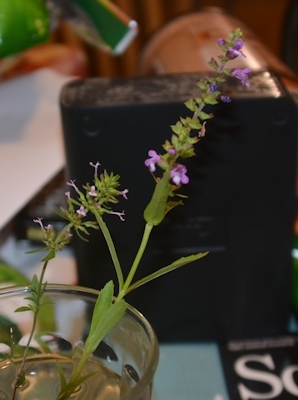
The two together in a glass of water. The Brazoria, the larger, is almost scentless; the tiny one, which has rosy-pink flowers that are darker red inside, grows thickly on damp areas of the east grass, is intensely aromatic. Some year I mean to collect leaves and try them in the kitchen--but they are tiny leaves. The whole plant grows only 4-6 inches tall.
Upstream from the obedient plants and tallgrass clumps, the old ditch is full of wild onions with other plants mixed in, and the field itself has Queen Anne's Lace, gaillardia, and gold thread, with Brazoria under the grass in the damper spots. The gaillardias have not peaked yet, and the rudbeckias and other coneflowers haven't started.

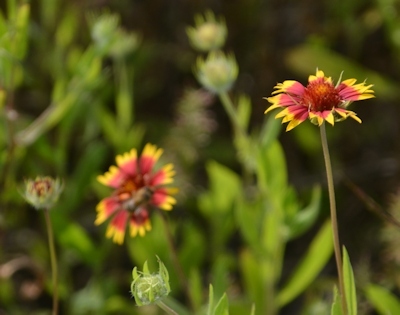
Gaillardia getting started--many more to come.

Main grass: Queen Anne's Lace, gaillardia, scattered bluebonnets
stiff-stem prairie flax, coreopsis, goldthread, Venus's looking glass,
skullcap, green antelope horns, others
With enough water running on the surface for long enough, we can have an abundance of wet-weather plants, including some in the mint family. One of the showiest is obedient-plant, which we transplanted planted a shovel-full of from a wet area about to undergo "development" somewhere else.

It grows several feet tall, if it's really happy--always at least 18 inches--with these big, glowing, lavender flowers that catch the light. Bees love it. The honeybees wrestle their way inside from the front; bumblebees more often bite a hole near the nectar.

It has slowly spread over the years since we introduced it--faster in wet years, of course. Right here it's growing with wild onion (at the end of its flowering) and is overlapping other flower types the bees enjoy. Bees were too busy toward late afternoon to let me catch them on anything but the obedient plant.
Although I didn't photograph bees on anything but this, I did see quite a few butterflies and caught this one on Queen Anne's Lace. It's a Common Buckeye, with the sun coming through one wing.

Also with a preference for damp soil--but not growing in water--is Venus's looking glass, a delicate little plant with purple star-shaped flowers along a single stem.

We don't see these in dry years.
On slightly damp ground, a smaller mint-family plant with lavender and white flowers:

Toward the bottom-center of image is another, even smaller mint-family plant just past flowering

The two together in a glass of water. The Brazoria, the larger, is almost scentless; the tiny one, which has rosy-pink flowers that are darker red inside, grows thickly on damp areas of the east grass, is intensely aromatic. Some year I mean to collect leaves and try them in the kitchen--but they are tiny leaves. The whole plant grows only 4-6 inches tall.
Upstream from the obedient plants and tallgrass clumps, the old ditch is full of wild onions with other plants mixed in, and the field itself has Queen Anne's Lace, gaillardia, and gold thread, with Brazoria under the grass in the damper spots. The gaillardias have not peaked yet, and the rudbeckias and other coneflowers haven't started.


Gaillardia getting started--many more to come.
Published on May 05, 2016 19:20
April 28, 2016
When Police Misbehave
An Austin Police Department officer, who lives in a nearby town, got into an argument with an older female neighbor--he was off duty, out of uniform, not in his jurisdiction, you will note. He came into her yard to confront her. She told him to get out of her yard. He didn't. From the images of both shown on TV last night, he is markedly bigger than she is--heavier and taller. She said if he didn't get out of her yard she would spray him with a garden hose. He continued to stay in her yard and argue with her. She sprayed him with the garden hose. He then physically attacked her, picking her up and throwing her onto the ground (I think it was the driveway, but am not certain) causing injuries for which she needed medical treatment.
An internal investigation by the Austin PD did not find he had done anything wrong, but the chief fired him. Now the police officers' association is mad at the chief, claiming that the officer did nothing wrong, didn't break any laws, and shouldn't have been fired. They claim he acted "in self defense." (Against being sprayed with a garden hose...while trespassing. Yeah, that really calls for a physical slam-down. NOT.)
It's bad enough that a police officer who is not in his jurisdiction, not on duty, and is not in the process of apprehending a criminal--just having an argument with a neighbor who is older, smaller, and on her own property--would trespass, refuse to get off her property, and then pick up and throw down this citizen because she got him wet.
It is worse that his fellow officers--and supposedly his entire chain of command except the police chief--see nothing wrong in what he did and accept the trespass, the refusal to leave, and the injury to the property owner as justified by "self-defense."
Because if it had been two other neighbors--big younger man, small older woman--and the man had invaded the woman's yard to yell at her more effectively, and refused to leave when asked, and she had sprayed him with a hose (getting his clothes wet, I suppose--it was a garden hose, not a fire hose) and he'd slammed her to the ground, injuring her, and she'd called the police...I will bet you that man would have been found to have committed the criminal offense of assault and battery, as well as trespass, as well as disturbing the peace (especially if he had been black and she had been white. She had a reasonable fear of injury when a larger man came onto her property and yelled at her. I believe police officers would see that if the perp had not been a police officer. I believe that the police officer in this case simply lost his temper (something police officers do, with the excuse that theirs is a hard life) and threw her down because he could and expected to get away with it, because BADGE.
Routinely, internal investigations find no fault in situations like this where the reasonable and educated citizen knows that the same act committed by anyone else is a crime. Routinely, law enforcement "stands behind" acts that are morally wrong, legally culpable, and indefensible except by those who, in their arrogance, claim the right to do anything they want any time they want no matter what.
And thereby are losing, steadily and inexorably, the respect of the populace. The bad apples--the ones who do these things and the ones in the force who support what they've done--destroy the reputation of the whole. Which is sad because there are still a lot of good, honest, law officers who are not like this fellow. Not like the man in Ohio who shot a 12 year old without giving him time to obey and then lied about what happened. Not like their chief and commissioner who suggested that the family should spend the settlement money on a program to teach black kids about the danger of having toy guns that look too real. Not like the Texas state troopers who performed a roadside cavity search on young girls...right out there in full view of everyone...because I guess they wanted to cop a feel. Not like the cops in New Mexico who--when a cavity search for drugs by a doctor came up with nothing ordered the hospital to give the man enema after enema just because they could...and then tried to lie about it. Or the ones in New Orleans and elsewhere who kept a "ham sandwich" in the car so they could plant a gun in someone's car or apartment...or the DAs who hide exculpatory evidence from the jury in order to get a conviction of an innocent citizen.
One of the reasons policing is harder now is that law enforcement has repeatedly not only done bad things, but failed to admit that they were bad. Coverups...excuses when the coverup is penetrated...the belief that sticking together, in a gang-like attitude, is more important than the oath they swore to serve and protect the population...all that has eroded citizens' trust in law enforcement, its willingness to work with them. Precisely because law officers are allowed more leeway when on duty than ordinary citizens--to enter property, to order people around--abuse of those powers makes things worse for them in the long run.
Good police officers have got to quit protecting the bad ones. They've got to start policing internally--seriously--telling jerks like the guy who threw an older woman down in "self-defense" (a patently stupid claim) that such behavior is wrong. Trespassing on a neighbor's property is wrong, and if you're asked or told to leave--you leave. Feeling girls up alongside the highway is wrong. Raping girls at a traffic stop (as one county constable did here years ago) is wrong. Planting evidence is wrong. Hiding evidence is wrong. Good officers need to be tough toward their own, and police chiefs are absolutely right to discipline or fire officers whose behavior brings the department into disrepute. Departments need to be honest with each other when hiring from another department. Police academies should flunk out, not keep in, cadets who--like the guy who shot Tamir Rice--are considered emotionally unstable and thus unsafe with firearms.
Additionally, officers need to have access to mental health care that will help them deal with the very real stresses of police work, and give them tools to manage their own problems--police officers have a higher rate of domestic violence than the average population, and often show signs of anger management and control issues. (A difficult shift before the current one is NOT a good reason to lose your temper, scream at a citizen, and beat on them.) Mental health visits should be standard, required, for all personnel at regular intervals and after any incident where violence is used, be it on assignment or otherwise.
An internal investigation by the Austin PD did not find he had done anything wrong, but the chief fired him. Now the police officers' association is mad at the chief, claiming that the officer did nothing wrong, didn't break any laws, and shouldn't have been fired. They claim he acted "in self defense." (Against being sprayed with a garden hose...while trespassing. Yeah, that really calls for a physical slam-down. NOT.)
It's bad enough that a police officer who is not in his jurisdiction, not on duty, and is not in the process of apprehending a criminal--just having an argument with a neighbor who is older, smaller, and on her own property--would trespass, refuse to get off her property, and then pick up and throw down this citizen because she got him wet.
It is worse that his fellow officers--and supposedly his entire chain of command except the police chief--see nothing wrong in what he did and accept the trespass, the refusal to leave, and the injury to the property owner as justified by "self-defense."
Because if it had been two other neighbors--big younger man, small older woman--and the man had invaded the woman's yard to yell at her more effectively, and refused to leave when asked, and she had sprayed him with a hose (getting his clothes wet, I suppose--it was a garden hose, not a fire hose) and he'd slammed her to the ground, injuring her, and she'd called the police...I will bet you that man would have been found to have committed the criminal offense of assault and battery, as well as trespass, as well as disturbing the peace (especially if he had been black and she had been white. She had a reasonable fear of injury when a larger man came onto her property and yelled at her. I believe police officers would see that if the perp had not been a police officer. I believe that the police officer in this case simply lost his temper (something police officers do, with the excuse that theirs is a hard life) and threw her down because he could and expected to get away with it, because BADGE.
Routinely, internal investigations find no fault in situations like this where the reasonable and educated citizen knows that the same act committed by anyone else is a crime. Routinely, law enforcement "stands behind" acts that are morally wrong, legally culpable, and indefensible except by those who, in their arrogance, claim the right to do anything they want any time they want no matter what.
And thereby are losing, steadily and inexorably, the respect of the populace. The bad apples--the ones who do these things and the ones in the force who support what they've done--destroy the reputation of the whole. Which is sad because there are still a lot of good, honest, law officers who are not like this fellow. Not like the man in Ohio who shot a 12 year old without giving him time to obey and then lied about what happened. Not like their chief and commissioner who suggested that the family should spend the settlement money on a program to teach black kids about the danger of having toy guns that look too real. Not like the Texas state troopers who performed a roadside cavity search on young girls...right out there in full view of everyone...because I guess they wanted to cop a feel. Not like the cops in New Mexico who--when a cavity search for drugs by a doctor came up with nothing ordered the hospital to give the man enema after enema just because they could...and then tried to lie about it. Or the ones in New Orleans and elsewhere who kept a "ham sandwich" in the car so they could plant a gun in someone's car or apartment...or the DAs who hide exculpatory evidence from the jury in order to get a conviction of an innocent citizen.
One of the reasons policing is harder now is that law enforcement has repeatedly not only done bad things, but failed to admit that they were bad. Coverups...excuses when the coverup is penetrated...the belief that sticking together, in a gang-like attitude, is more important than the oath they swore to serve and protect the population...all that has eroded citizens' trust in law enforcement, its willingness to work with them. Precisely because law officers are allowed more leeway when on duty than ordinary citizens--to enter property, to order people around--abuse of those powers makes things worse for them in the long run.
Good police officers have got to quit protecting the bad ones. They've got to start policing internally--seriously--telling jerks like the guy who threw an older woman down in "self-defense" (a patently stupid claim) that such behavior is wrong. Trespassing on a neighbor's property is wrong, and if you're asked or told to leave--you leave. Feeling girls up alongside the highway is wrong. Raping girls at a traffic stop (as one county constable did here years ago) is wrong. Planting evidence is wrong. Hiding evidence is wrong. Good officers need to be tough toward their own, and police chiefs are absolutely right to discipline or fire officers whose behavior brings the department into disrepute. Departments need to be honest with each other when hiring from another department. Police academies should flunk out, not keep in, cadets who--like the guy who shot Tamir Rice--are considered emotionally unstable and thus unsafe with firearms.
Additionally, officers need to have access to mental health care that will help them deal with the very real stresses of police work, and give them tools to manage their own problems--police officers have a higher rate of domestic violence than the average population, and often show signs of anger management and control issues. (A difficult shift before the current one is NOT a good reason to lose your temper, scream at a citizen, and beat on them.) Mental health visits should be standard, required, for all personnel at regular intervals and after any incident where violence is used, be it on assignment or otherwise.
Published on April 28, 2016 20:56
April 26, 2016
Socks and Sandals
I finished the royal blue socks last night, too late to take a picture. Here they are in late afternoon sunlight and shadow:
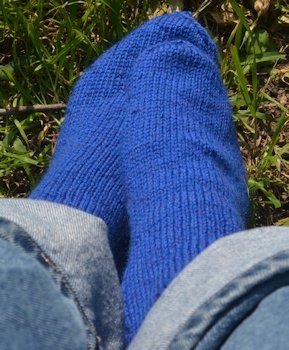
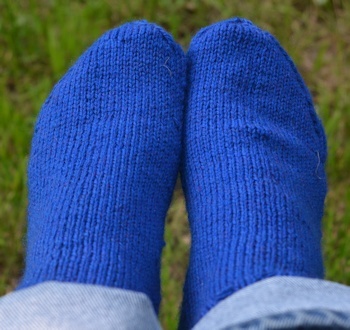
They are fresh off the needles--not washed, not blocked, not worn yet. They will be worn for the 24 break-in tomorrow. Last week I bought new sandals (the old ones are still wearable but the time I got into quick-mud (like quicksand only black clay) seems to have caused some stretching and a little discoloration. I will continue to wear them, but when I saw these, I could not resist:

Here they're worn over turquoise and lavender striped short socks.
And this is how they look over the new royal blue socks:



They are fresh off the needles--not washed, not blocked, not worn yet. They will be worn for the 24 break-in tomorrow. Last week I bought new sandals (the old ones are still wearable but the time I got into quick-mud (like quicksand only black clay) seems to have caused some stretching and a little discoloration. I will continue to wear them, but when I saw these, I could not resist:

Here they're worn over turquoise and lavender striped short socks.
And this is how they look over the new royal blue socks:

Published on April 26, 2016 15:35
April 24, 2016
80 Acres: Earth Day 2016, Part 1
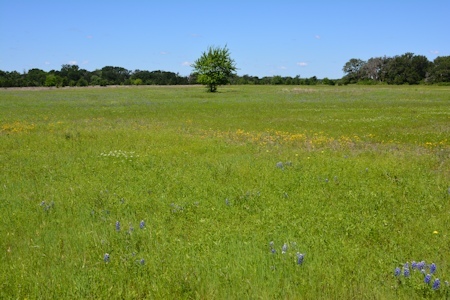
Earth Day 2016
It had rained in the day before, and dawned cool, with a northeast breeze--a perfect day to go checking the water quality on the east half of the place. Not as much rain as the previous weekend, so with some difficulty I was able to make it from place to place in ordinary walking shoes. In the distance, the line of woods along the seasonal creek; to the left the "dry woods" growing on a hump of rock. Out of sight to the left, the line of trees along an old ditch dug by a former farmer, intended to carry runoff from the highway to the south property line . A beautiful day, with signs of recovery from the drought...and signs of much management still needed.
I have no equivalent pictures of what the place looked like 30-odd years ago when we moved to this town. We didn't have a digital camera, and we didn't own the 80 acres. It was then under the management of a decent-enough farmer who leased it and ran some cattle on it--but with care. I had permission to ride my horse out on it, and did so. It was slightly overgrazed, and the farmer disked and planted "improved" pasture grasses in one area, sometimes mixed with red-top. Up at the highway end, the owner sold a corner to someone who wanted to build an auto-repair place. Later, a construction firm moved in, and wanted more land; the owner sold it, making significant notch on that end. The farmer who'd been leasing it grew older, died, and both his place (adjoining this, west of our 3 acres) and this were leased to a man who ran as many cattle on it as he could. Grass diminished. Ashe juniper invaded; he didn't clear it off; there were hundreds, both east and west of the dry woods. The two gates by which cattle left this field had deep gouges in hardpacked dirt (or deep mud, when it rained) and erosion occurred even in a two inch rain.
In 2000, when we had the chance to buy it, grass had been eaten down to the dirt; some areas had less than 5% vegetative coverage; very little had thick native grass, the junipers were 3-5 feet tall, closing in. Land purchases take time; we got permission to start clearing the Ashe juniper that winter, and took possession in early 2001, insisting that the cattle be moved off. Fences were all bad. Broomweed, thistles, compaction in some areas from the number of cattle, serious erosion in multiple sites, especially the creek flood overflow channels. But we had seen that native plants were there--here and there, in little groups. The old, tough prairie grasses: switchgrass, little bluestem, Indiangrass, and more. The native forbs, too: Maximilian sunflower, frostweed, basketflower, the common wildflowers people plant (bluebonnets, rudbeckia, gaillardia, prairie verbena) and the ones they don't: Brazoria, Texas sage, gaura and false gaura and more.
So the work began. Water management--to prevent erosion, to hold rainfall and runoff on the land longer, so it can soak in and maintain soil moisture and replenish groundwater, to allow revegetation to take hold and provide protection both from intense rain and from moving water--was the first priority. And this--smaller then, and built against the old fence you can see lurking behind the new one was the first, rocks laid across the old gate between our place the the one to the south:
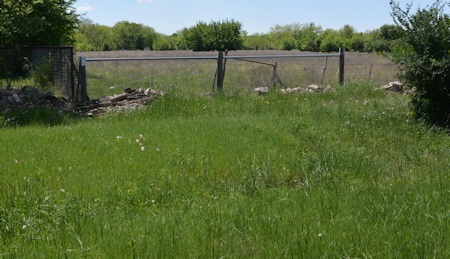
Old #1 Gabion
The original was built with rocks--smallish rocks--we picked up on the place (enough soil had washed away that picking up small rocks was easy) wrapped in old chicken wire. It took garden-carts full of little rocks. We couldn't afford to buy rock at that time. Now it's reinforced by larger, heavier rocks, but even in its early stages it slowed water down some and kept some of the soil on our side. Periodically a big flash flood shifts things, and it needs repair (it needed repair last year, when we had twice the annual rainfall after years of drought, so the soil-holding capacity of roots had been degraded. Except in the heaviest rains, water runs clear when it leaves our place even though dirty water enters from the highway along the east end and from the construction yard.
The second gabion was built on the other gate cattle had used, where the soil loss was even greater. The third was built upstream of this one, across the "scour" where water from the old ditch and natural drainage from above converged to flood this meadow. It is now the main protector of the meadow, holding back a large pool after big rain events, and releasing it slowly across the meadow.

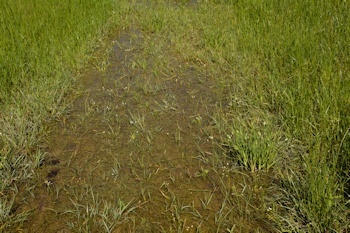
4-18-16: after very heavy rain, water flows almost clear; after another smaller rain that week, on 4-22-16 it's flowing completely clear. Instead of digging a trench on old cattle trails, the flow is now wide, shallow, and much slower. Native grasses and forbs now fill this drainage.
Here's the back side of the #3 gabion with water and a lot more vegetation than it had when we started, when it was across a bare scoured place, and the water clarity in one of its associated upstream pools.
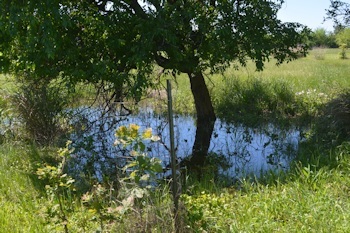
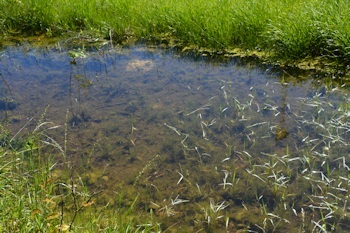
These pools provide habitat for aquatic life, such as crayfish (note burrow sign in R image), amphibians, odonate larvae, and others. Crayfish did not survive the years' long drought but returned this winter after rain restored soil moisture. These pools provide water for other wildlife much longer than the previous fast-moving and fast-disappearing runoff, and they have supported revegetation. They are shallow, however, and thus subject to relatively fast evaporative loss, compared to deeper ones. It would be ideal to dig out the main gabion pool (esp. at the low end) but we don't have the time or strength. There are many other chores to do, from finishing the rebuilding of the north fence, rebuilding the east fence on the highway, maintaining checkdams after floods, mowing. maintaining the rain barns, pumps, and guzzlers that provide wildlife water when the natural features are dry, replanting native vegetation (still ongoing), and documenting what use wildlife is making of which parts of the place.
Here's a failure that must be dealt with this year:

The city's new water supply comes from a lake to the north (wells failed, in the drought) and required some construction on a corner of the 80 acres. Despite discussion with the project engineer, in the event the construction crew were not careful, created deep ruts from heavy equipment and a supposed "erosion preventive" fence that diverted water onto a more vulnerable area and this happened. It's headward erosion from the side of a natural drainage channel. Note the little clump of soil with grass in the midst of the water. This is going to require a new, large, wide, checkdam joining the one (just out of sight to the right) that stopped headward erosion of is drainage channel initially. Right now, we can't take the rocks out there, because the ground is so wet and we don't want to break what vegetation cover we have (and hauling rocks, even in a child-sized wagon, puts a lot of weight on tires.) When it's a little dryer, I'll start picking up any rocks in the area by hand and get things started. And when it's good and try, we'll try to get a truckload (5 cubic yards) of appropriately sized rocks somewhere back near the gate, so we can haul a cartload out every day or so.
Even with this problem, water quality coming off the east grass looks good shortly after storms, both in the old ditch and in the natural drainage.


Left: natural drainage, series of shallow rock-bottomed pools, clear water. Right: old ditch, once bare, now heavily vegetated, with both linear pools and water running through solid vegetative cover. In distance of right image, dark line reveals the original natural drainage channel; these channels converge upstream of #3 gabion, where cattle had broken through the old ditch structure. We built a large check-dam there, and smaller ones between the pools above the gabion itself...and then more checkdams upstream on the natural drainagin to slow drainage from a large seepy area. These began holding soil quickly, and transplants of switchgrass where then successful--and now contribute to the filtration and soil holding.
On Earth Day, these small pools were being visited by both dragonflies and damselflies, including damselflies mating and ovipositing:
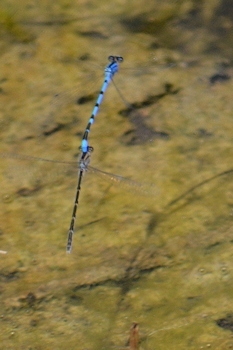
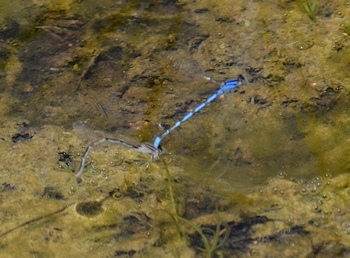

"Manage the water, and the land (and wildlife) will take care of itself."
Published on April 24, 2016 20:19
April 18, 2016
80 Acres: After More Rain, Water Quality Checks
The sooner you get into the field after a large rain event the better, especially here. This involves rubber boots (mine leaked today...I bought women's boots last time. Just sayin'.) What you want to see is how the water's moving on the land, if any checkdams or gabions have been damaged, where erosion is active (you hope for nowhere, but there's usually some if there's been hard heavy rain), how the creek is doing, etc. Coming down the near meadow, this is what I saw:
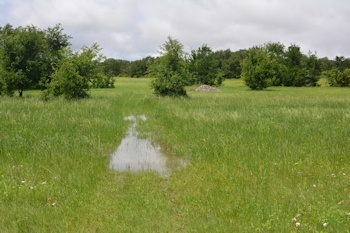
Water is flowing right to left.
When I got close enough, I could see a pale "cloud" of sediment in the near end of the broad shallow stream.
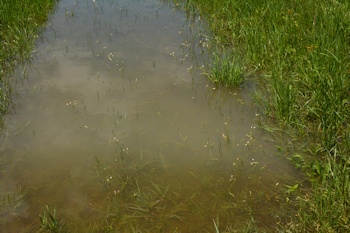
"Darker" water closer and farther away is clearer. This sediment washes down from
construction yard upslope to the right, and is not caught by a gabion. Grass
and other plants filter most of it out by the low end of the meadow.
Headng for the creek, I walked up to the dry woods, to look at runoff on that slope; all the water was very clear, no visible sediment, and moving slowly; the existing grass & forbs appeared to be doing their job. The dry woods swale does not fill from runoff, but is a seep, and if there's enough rain, it will begin to fill tomorrow. Plants have filled in most of the bottom of the swale, after the last period of seepage. They must tolerate alkaline water, as the seepage comes through limestone; there's an outcrop forming the hump where the dry woods are.
At the corner of the dry woods, I flushed a small covey of bobwhite quail; they flew down the west grass slope and dropped into the grass near the creek woods. The west grass bluebonnets are still in full bloom.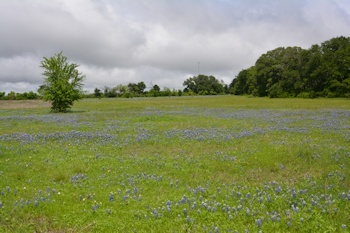 Near here, I flushed a grasshopper sparrow, first of the day.
Near here, I flushed a grasshopper sparrow, first of the day.
Not the only one; I flushed another one later..
Walking on down to the creek, I notes the quality of runoff from the slope, judging by where it was pooled up against one of the old terrace berms: good and clear, and no signs of scouring on the upslope side of the water.
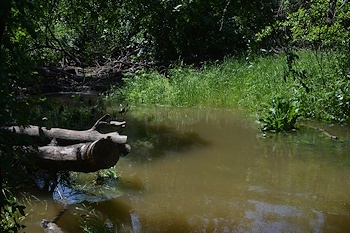
Creek is about 10-12 inches above level last week, and turbid
Debris in caught in bush suggests it was a foot higher earlier.
On the way back from the creek, I went up the north fenceline and found a native, white limestone honeysuckle, in full bloom, with butterflies and bees arriving as the sun strengthened.
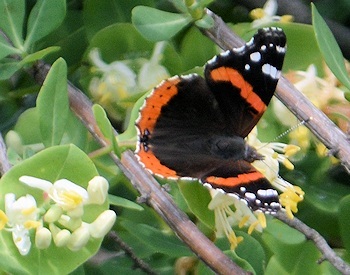
Red Admiral nectaring on honeysuckle. Gray Hairstreak,
and Paintied Lady butterflies, and bees, were also busy on this bush.
At the top of the slope, near the dry woods, I found a Green Antelope Horns milkweed in flower. We used to have Antelope Horns (whiter) first, and then the Green Antelope horns, but I had not seen any for several years; the drought got them.
This one has a large milkweed bug on it (orange and black) and behing the floret
the bug is on, is a little crab spider, visible when I enlarged the image.
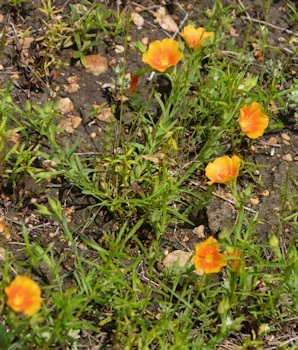
Stiff-stem Prairie Flax grows mostly south of the dry woods, on the upper part of that slope.
On the way in, I checked water quality at the low end of the near meadow. And then, later, we had soup leftover from the big pot I made Saturday.
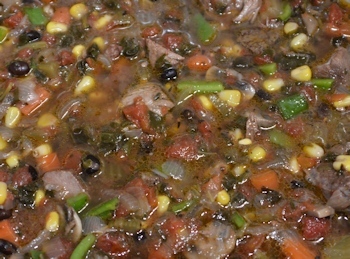
Beef, the nub end of a summer sausage diced up, two strips of bacon, onion, celery, carrot, mushrooms, corn, black beans, tomatoes, green chilis, various herbs and stuff. Livened up today with a diced green Bell pepper for crispness.

Water is flowing right to left.
When I got close enough, I could see a pale "cloud" of sediment in the near end of the broad shallow stream.

"Darker" water closer and farther away is clearer. This sediment washes down from
construction yard upslope to the right, and is not caught by a gabion. Grass
and other plants filter most of it out by the low end of the meadow.
Headng for the creek, I walked up to the dry woods, to look at runoff on that slope; all the water was very clear, no visible sediment, and moving slowly; the existing grass & forbs appeared to be doing their job. The dry woods swale does not fill from runoff, but is a seep, and if there's enough rain, it will begin to fill tomorrow. Plants have filled in most of the bottom of the swale, after the last period of seepage. They must tolerate alkaline water, as the seepage comes through limestone; there's an outcrop forming the hump where the dry woods are.
At the corner of the dry woods, I flushed a small covey of bobwhite quail; they flew down the west grass slope and dropped into the grass near the creek woods. The west grass bluebonnets are still in full bloom.
 Near here, I flushed a grasshopper sparrow, first of the day.
Near here, I flushed a grasshopper sparrow, first of the day.Not the only one; I flushed another one later..
Walking on down to the creek, I notes the quality of runoff from the slope, judging by where it was pooled up against one of the old terrace berms: good and clear, and no signs of scouring on the upslope side of the water.

Creek is about 10-12 inches above level last week, and turbid
Debris in caught in bush suggests it was a foot higher earlier.
On the way back from the creek, I went up the north fenceline and found a native, white limestone honeysuckle, in full bloom, with butterflies and bees arriving as the sun strengthened.

Red Admiral nectaring on honeysuckle. Gray Hairstreak,
and Paintied Lady butterflies, and bees, were also busy on this bush.
At the top of the slope, near the dry woods, I found a Green Antelope Horns milkweed in flower. We used to have Antelope Horns (whiter) first, and then the Green Antelope horns, but I had not seen any for several years; the drought got them.

This one has a large milkweed bug on it (orange and black) and behing the floret
the bug is on, is a little crab spider, visible when I enlarged the image.

Stiff-stem Prairie Flax grows mostly south of the dry woods, on the upper part of that slope.
On the way in, I checked water quality at the low end of the near meadow. And then, later, we had soup leftover from the big pot I made Saturday.

Beef, the nub end of a summer sausage diced up, two strips of bacon, onion, celery, carrot, mushrooms, corn, black beans, tomatoes, green chilis, various herbs and stuff. Livened up today with a diced green Bell pepper for crispness.
Published on April 18, 2016 22:00
Supreme Court Screws Writers, Photographers, Artists
Some years back, Google and a group of university libraries colluded to infringe writers' copyrights under the guise of making orphan works available to the public by digitizing books out of copyright. Just as the Gutenberg Project had been doing, only--being Google--they wanted to digitize everything in a bunch of libraries and eventually monetize their big private bunch of stuff. As they went at it--they and the libraries--they paid no attention to whether the works in question were in copyright or out of it, in print or out of it, already available to the public in bookstores, or not. They just digitized everything, without contacting authors or publishers or bothering their heads about copyright violation. Because, Google insisted, they were Serving Humanity and writers and artists and photographers were on the menu. We don't count.
It was a crime. But they just got away with it forever, because they're a big rich company with very deep pockets, and the writers, artists, and photographers whose rights they infringed are individuals who don't have deep pockets even if they belong to writers' organizations like SFWA. Although the first suit against Google succeeded, with a judgment in favor of the facts: that Google did indeed infring copyright and was wrong to do so--they won an appeal, and the Supreme Court has refused to hear an appeal of that appeal.
I am angry and disgusted.
It was a crime. But they just got away with it forever, because they're a big rich company with very deep pockets, and the writers, artists, and photographers whose rights they infringed are individuals who don't have deep pockets even if they belong to writers' organizations like SFWA. Although the first suit against Google succeeded, with a judgment in favor of the facts: that Google did indeed infring copyright and was wrong to do so--they won an appeal, and the Supreme Court has refused to hear an appeal of that appeal.
I am angry and disgusted.
Published on April 18, 2016 20:42
Knitting = Thinking. Sometimes
When I started knitting socks, using worsted-weight yarn, I used size 5 US needles. I knew my mother had used size 4s to make the socks she made me, but I found it easier to see what I was doing with size 5s. I created the pattern for those socks on my feet (trying the socks on repeatedly, and correcting from pair to pair until, with #4, I had something that suited me. I'm a fairly tight knitter, so I was getting 6 1/2 stitches/inch and 8 rows/inch consistently, a dense enough fabric for the socks to last a reasonable time in the heavy use I give socks. Variations in one yarn or another weren't enough to affect the socks' fit. But I knew that dropping down to size 4 US needles would make a denser fabric tht should last even longer. The problem was...gauge. Taking the time to figure out my size 4 gauge in the round meant a slowdown in sock production and not until this spring did I feel I had enough backlog of socks to afford the time.
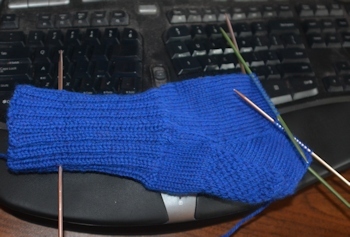
Ribbing w/ #5 US needles, rest with #4 US
I first tried out knittig with #4 needles when finishing a pair that my mother had started (for herself) for a friend whose feet were my mother's size. That proved I could now (being more experienced) see the stitches well enough to make socks like that. I made two more pair using first my mother's old acrylic yarn and then one in wool. Then, on the Birthday Socks this spring, I knit one section with size 4s...the stockinette between the ribbed cuff and the heel flap. I did one with the same stitch count as number 5s (a little snugger than I like) and added two stitches (actually, did not reduce 4 st. between ribbing and stockinette, as I usually do) to that section, which produced the fit I wanted. With #4s, I get 7 st./inch in stockinette and 10 rows to the inch, instead of 8. Since the ribbed cuff doesn't wear out fast, I knit the ribbing of the current test pair (royal blue) on #5s, switching to #4s at the ankle, and using the stitch count I'd found worked on the Birthday socks. I left the "front" of the sock with the extra stitches, knitting the heel flap with the familiar number, to see how I liked it. Heel flap position on my heel...the heel flap difference in "wrap around" is about half an inch...a quarter inch on each side. Next pair I do on #4s, I'll do the reverse, and see if I like the wider heel flap better. I will need to wear the socks and walk some miles on the land in them to see if the narrower heel flap will work for me, and if the same stitch count in the middle--the "cup" for the heel--feels right.
Figuring the gusset decreases took real consideration. First, beause of the difference in row gauge, there were more stitches to be picked up. I have both a high instep and a high arch...a very long circumference around the back of my heel pad and the top of the instep, and then a steep decline in circumference as the arch rises fast from the heel. On #5 needles, I've been decreasing two rows, decrease one, to ensure no extra fabric under the arch. On the #4s, I checked the fit every row, and found that I needed to combine both that rate of decrease and the 1:1 ratio usually suggested. After the last non-decrease row, I could decrease that one extra stitch off the top needles, back to even stitches on each needle. There's another decrease (below the "bump" on the top of the foot) coming up soon. And then the work to get the toe fit right for L and R feet.
Stitch counts compared so far: Size 5 US needles Size 4 US needles
Ribbed cuff 60 (not tried)
Ankle 56 58
Heel flap 28 28
Instep needles 28 30
After gusset 54 -->52 56 -->? (not there yet)
Using a smaller needle puts more wool in the project--denser fabric that should last longer--but also uses up yarn faster (of course) and take longer to knit for a slow knitter like me. Every stitch takes the same amount of time, with either size needle, and puts the same wear and tear on my finger joints...so more stitches per sock means more wear on my joints. Also, though I can still see stitches well enough, increasing vision problems, especially for close work, mean that eyestrain is more using #4s. I plan to use them for mitts, but am discovering just how much harder it is to work with, essentially, one eye (the one that still has a cataract. The other eye has a focal point problem.)
I will use this pair, when it's done, to figure out whether it's worth the extra yarn and effort for the amount of durability gained. This pair will be charted (number of days worn) and I will wear it more frequently, probably once a week, to get the answer faster. If I can finish a pair of socks done in #4 needles in a month (about what it takes me now with #5s) I may start using #4s for some of the socks.

Ribbing w/ #5 US needles, rest with #4 US
I first tried out knittig with #4 needles when finishing a pair that my mother had started (for herself) for a friend whose feet were my mother's size. That proved I could now (being more experienced) see the stitches well enough to make socks like that. I made two more pair using first my mother's old acrylic yarn and then one in wool. Then, on the Birthday Socks this spring, I knit one section with size 4s...the stockinette between the ribbed cuff and the heel flap. I did one with the same stitch count as number 5s (a little snugger than I like) and added two stitches (actually, did not reduce 4 st. between ribbing and stockinette, as I usually do) to that section, which produced the fit I wanted. With #4s, I get 7 st./inch in stockinette and 10 rows to the inch, instead of 8. Since the ribbed cuff doesn't wear out fast, I knit the ribbing of the current test pair (royal blue) on #5s, switching to #4s at the ankle, and using the stitch count I'd found worked on the Birthday socks. I left the "front" of the sock with the extra stitches, knitting the heel flap with the familiar number, to see how I liked it. Heel flap position on my heel...the heel flap difference in "wrap around" is about half an inch...a quarter inch on each side. Next pair I do on #4s, I'll do the reverse, and see if I like the wider heel flap better. I will need to wear the socks and walk some miles on the land in them to see if the narrower heel flap will work for me, and if the same stitch count in the middle--the "cup" for the heel--feels right.
Figuring the gusset decreases took real consideration. First, beause of the difference in row gauge, there were more stitches to be picked up. I have both a high instep and a high arch...a very long circumference around the back of my heel pad and the top of the instep, and then a steep decline in circumference as the arch rises fast from the heel. On #5 needles, I've been decreasing two rows, decrease one, to ensure no extra fabric under the arch. On the #4s, I checked the fit every row, and found that I needed to combine both that rate of decrease and the 1:1 ratio usually suggested. After the last non-decrease row, I could decrease that one extra stitch off the top needles, back to even stitches on each needle. There's another decrease (below the "bump" on the top of the foot) coming up soon. And then the work to get the toe fit right for L and R feet.
Stitch counts compared so far: Size 5 US needles Size 4 US needles
Ribbed cuff 60 (not tried)
Ankle 56 58
Heel flap 28 28
Instep needles 28 30
After gusset 54 -->52 56 -->? (not there yet)
Using a smaller needle puts more wool in the project--denser fabric that should last longer--but also uses up yarn faster (of course) and take longer to knit for a slow knitter like me. Every stitch takes the same amount of time, with either size needle, and puts the same wear and tear on my finger joints...so more stitches per sock means more wear on my joints. Also, though I can still see stitches well enough, increasing vision problems, especially for close work, mean that eyestrain is more using #4s. I plan to use them for mitts, but am discovering just how much harder it is to work with, essentially, one eye (the one that still has a cataract. The other eye has a focal point problem.)
I will use this pair, when it's done, to figure out whether it's worth the extra yarn and effort for the amount of durability gained. This pair will be charted (number of days worn) and I will wear it more frequently, probably once a week, to get the answer faster. If I can finish a pair of socks done in #4 needles in a month (about what it takes me now with #5s) I may start using #4s for some of the socks.
Published on April 18, 2016 10:20
April 13, 2016
Autonomous Vehicles
Since I'm in and out of Austin a couple of times a week, and Austin is one of the cities where Google's been testing its driverless cars, I've seen some. And since I'm over 70, and in my family (both sides) eyesight fails with age, I had been thinking of a driverless car as the ideal assistant for someone who lives a long way from public transportation but can't drive...for any of a number of reasons. Yet nothing I've read about driverless cars has dealt with the interface between the operator and the vehicle: how to specify a destination, how to specify a route to a destination if the operator has a preferred route (that may not be the shortest or most obvious.)
Why does being able to specify the route matter? Because Google Maps (and other earlier and still existing navigation programs) are so often wrong, or choose the efficiency of taking the largest road rather than smaller ones that are actually more efficient (or less dangerous, or less subject to flooding in a storm period...) I have now quit using I-35, for instance, except on early Sunday mornings. I've been caught in too many traffic jams (one, lasting two hours, cost me an extra trip to a post office to get my passport renewed.) So I go into Austin via a smaller highway, happily putting up with some stoplights in some towns along the way for less stress (sitting in a traffic jam is stressful to me, and so is the crazy traffic on the interstate that causes the accidents that cause the jams.)
And of course, the operator needs to be able to tell the vehicle where the operator wants to go. In my case, for both fuel and time economy, many trips to the city involve multiple destinations, in and out of grocery store and other store parking lots, to a friend's house, etc., and if they're familiar ones I know short-cuts and back ways to avoid various hazards. How would entry to downtown garages be handled, where the driver must take a ticket from a machine to gain entry, and hand in one (or two--in case of one I use every week) tickets to a machine to get out? This means that in all weather conditions, in bright sunlight and at night, I need to be able to communicate to the car where to go, including (for mall parking lots) choosing a parking space within my walking capacity (which isn't impaired enough to qualify for handicapped parking, but is sometimes impaired enough to make the last row out too far, especially if it's a slope and I'll be walking back uphill with purchases.) How is that done? Judging by the way high-tech companies ignore the visually impaired customer (my current desktop is a prime example, with tiny, barely incised black on black symbols for things you plug into the front of it--can't feel them, can't see them without a magnifying glass and strong angled light), I foresee that the very people an autonomous vehicle might find most useful could end up being useless because no one considered them in designing the control interface.
Why does being able to specify the route matter? Because Google Maps (and other earlier and still existing navigation programs) are so often wrong, or choose the efficiency of taking the largest road rather than smaller ones that are actually more efficient (or less dangerous, or less subject to flooding in a storm period...) I have now quit using I-35, for instance, except on early Sunday mornings. I've been caught in too many traffic jams (one, lasting two hours, cost me an extra trip to a post office to get my passport renewed.) So I go into Austin via a smaller highway, happily putting up with some stoplights in some towns along the way for less stress (sitting in a traffic jam is stressful to me, and so is the crazy traffic on the interstate that causes the accidents that cause the jams.)
And of course, the operator needs to be able to tell the vehicle where the operator wants to go. In my case, for both fuel and time economy, many trips to the city involve multiple destinations, in and out of grocery store and other store parking lots, to a friend's house, etc., and if they're familiar ones I know short-cuts and back ways to avoid various hazards. How would entry to downtown garages be handled, where the driver must take a ticket from a machine to gain entry, and hand in one (or two--in case of one I use every week) tickets to a machine to get out? This means that in all weather conditions, in bright sunlight and at night, I need to be able to communicate to the car where to go, including (for mall parking lots) choosing a parking space within my walking capacity (which isn't impaired enough to qualify for handicapped parking, but is sometimes impaired enough to make the last row out too far, especially if it's a slope and I'll be walking back uphill with purchases.) How is that done? Judging by the way high-tech companies ignore the visually impaired customer (my current desktop is a prime example, with tiny, barely incised black on black symbols for things you plug into the front of it--can't feel them, can't see them without a magnifying glass and strong angled light), I foresee that the very people an autonomous vehicle might find most useful could end up being useless because no one considered them in designing the control interface.
Published on April 13, 2016 10:03
April 12, 2016
Breathe In, Spring Is Here
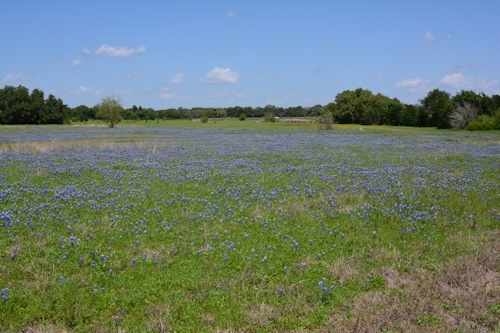
Warm day (high 80sF) and breezy--the fragrance rolls over you in waves
Bluebonnets have a lush, rich perfume that makes me want to breathe in forever.
Some of the bluebonnets are past peak (peaked last week) and some are at peak now:
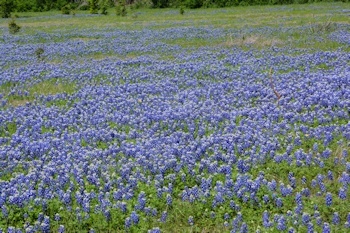 Soil depth & content affects speed of going to seed as does exact timing and amount of rainfall through the growing season. In drought years they're only 2-3 inches tall with small flowers, and notas dense, but they will still seed.
Soil depth & content affects speed of going to seed as does exact timing and amount of rainfall through the growing season. In drought years they're only 2-3 inches tall with small flowers, and notas dense, but they will still seed. 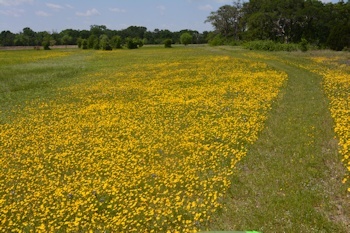
Carpet of Gold--Goldthread, one of many yellow spring flowers
Mowed path keeps walkers from surprising rattlesnakes.
Goldthread is growing on a gentle slope from solid rock (on R) where
it's scattered, to slightly deeper soil on left down to a seepy area that's too
wet for it some years. In other years it will fill that hollow, to get enough moisture.
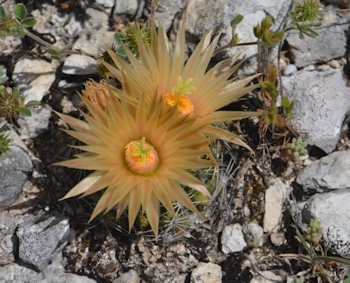

Tiny ball-shaped cactuses with flowers wider than the cactus. These are growing on thin soil (<1 inch) and decomposing rock or solid rock. They will also grow on well-drained soil that's deeper; there's a cluster that sometimes produces a dozen of these flowers at once. They're uncommon around here, and sometimes disappear from a site where they've bloomed for several years and then (sometimes) return.)

Blue-eyed Grass, an iris relative, a different blue than bluebonnets.
Centers are yellow (making the name odd) but "charming." There's another
native grassland iris I'd love to have, but it prefers wetter situations and isn't here.

Stripes of color reveal contour, soil variations, and timing of fall/winter mowing
It was a great day to be out, with the warm air moving the various fragrances around. This isn't all the wildflowers that were out, either--some only in small clumps (the brilliant white "bouquets" of Blackfoot Daisy, the delicate pinks and lavenders of Drummond Wild Onion, the Pink Evening Primroses, others) but time ran out, and I still haven't run all of them through my photo processing software. I was distracted, in part, by this:

In the creek, which is falling now, and this end heavily involved with algae, so the water is not as clear as it has been. My best guess so far is a species of Percina, a logperch. If it's a logperch, it's an adult (or almost adult--it's adult size at about 4-5 inches) but if it's not a logperch, it could be a juvenile of something else. Investigation is ongoing. It's fast and wary--I suspect herons have been down there hunting fish.
Published on April 12, 2016 09:48
Elizabeth Moon's Blog
- Elizabeth Moon's profile
- 2621 followers
Elizabeth Moon isn't a Goodreads Author
(yet),
but they
do have a blog,
so here are some recent posts imported from
their feed.



